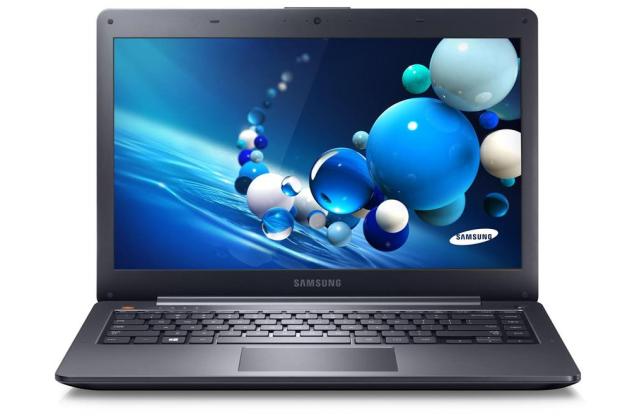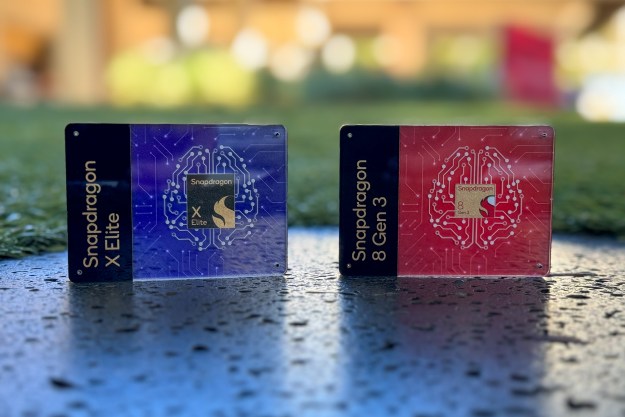
“Though the build quality, decent keyboard, and long battery life make Samsung’s Ativ Book 5 seem attractive, competitors offer more value considering its inconsistent performance and poor display.”
- Good build quality
- Edge-to-edge glass touchscreen
- Above-average battery life
- Boring design
- Exceptionally dull display
- Below-average performance
- Not a good value
Most spotlight-grabbing Ultrabooks are expensive, with prices that start around $1,000 and can come close to $2,000 with the right options. These flagships are proof that PC manufacturers have finally learned how to build premium products, but they don’t make up the bulk of sales. Most systems are still far below the thousand-dollar mark.
Samsung’s entry in the hotly contested market for inexpensive Ultrabooks is the Ativ Book 5, a 14-inch system packing a touchscreen, third-gen Intel Core processor, and 4GB of RAM, all of which comes at an MSRP of $850. A less expensive version with a Core i3 processor is also available for $700.
Though competitively priced, this laptop breaks no new ground, nor does its spec sheet offer any highlights. This leaves Samsung to excel on the merits of its design. Let’s see if the Ativ Book 5 stands out from the crowd.
Sleek and subtle
Samsung has proven it can do premium with the Ativ Book 8 and other entries, but there’s less room for expensive metal in a mid-range laptop’s budget. This system can only afford metal on its lid, which means plastic is the order of the day everywhere else. Fortunately, the materials feel thick and sturdy rather than cheap, and the use of matte paint wards away fingerprints. There’s a whiff of no-nonsense professionalism to the Ativ Book 5, and it looks and feels built to get things done.
There are a few hints of luxury, however, such as an edge-to-edge glass display, thin bezels, and a few strips of chrome trim. Small touches like this don’t quite keep pace with Lenovo’s friendly U310 or the entry-level Asus Zenbook (which can be had for just $560), but they do keep the aesthetic gap between this laptop and its competitors from turning into a chasm.
Quality is a strong point of the Ativ Book 5. Panel gaps are tight, there’s almost no flex in the chassis, and the display hinge is one single piece of material that does a good job of keeping the screen in place. These traits reinforce the system’s business-like demeanor and inspire immediate confidence.
No fanfare for connectivity
The Ativ Book 5 has three USB ports (one 3.0, two 2.0), HDMI, mini-VGA (via dongle), Ethernet, a card reader, and a combo headphone/microphone jack. The lone USB 3.0 port does not compare favorably to the competition, and while we appreciate VGA, we’d rather see DisplayPort. Overall, Samsung is a bit behind the competition in this area.
Can’t complain about keys
A 14-inch display provides plenty of interior space, and Samsung has made ample use of the room. The Ativ Book 5 boasts a wide keyboard with large key caps, a sensible layout, and decent key feel. Touch typists should have no trouble.
There’s a whiff of no-nonsense professionalism to the Ativ Book 5, and it looks and feels built to get things done.
Backlighting is standard and offers three brightness settings (not including off). Some light leak is visible, but never unbearable, so the keyboard is easy to use no matter the lighting available.
The touchpad is also competent and incredible. There’s plenty of space for executing gestures, and the surface’s chrome bezel defines it well from the surrounding palmrest. We would have liked for the integrated buttons to provide more feedback, however, as their use results in just a smidge of movement and a hollow plastic click.
An exceptionally poor display
Inexpensive Ultrabooks often make do with 1366 x 768 resolution, and the Ativ Book 5 is no exception. Not all such displays serve up the same quality, however, and the one found on this Ultrabook posted the worst scores we’ve witnessed in months.
Our test suite showed the display can render just 58 percent of the sRGB gamut. Black levels are among the worst we’ve recorded, and overall contrast is far below average. Maximum brightness is low, as well, which makes the glossy edge-to-edge touchscreen difficult to use in a brightly lit room.

Take it to go
The Ativ Book 5 weighs in at about 4.3 pounds, which is average for a system of this size. Thickness comes in at about 0.8 inches, and the AC adapter doesn’t take up much room. Most travelers won’t have much trouble finding room for this laptop, though there are many lighter and smaller Ultrabooks available.
Everything about the system is conservative, from design to specifications.
Power tests showed nothing unusual. Our wattmeter reported 10 watts of power draw at idle with the display at 100 percent brightness, while full load increased draw to about 26 watts. Neither figure differs from the average Ultrabook.
Not a quick one
Our review unit arrived with a Core i5-3337U processor, 4GB of RAM, and a 500GB mechanical hard drive paired with a solid-state cache drive. While the processor managed a score of 39.31 GOPS in SiSoft Sandra, it struggled in 7-Zip, reaching a below-average score of 6,068. Most Ultrabooks score 7,000 or better in that test.
PCMark 7 also returned a disappointing score of 2,490. The system’s weakness seems to be the 500GB hard drive, which struggles to provide quick access. At times, the system will momentarily freeze as the disk spins up to access a program or even a menu, which makes the Ativ Book 5 feel far less responsive than some competitors.
All versions of this laptop come with Intel HD 4000 integrated graphics. As usual, they don’t do games any favors. 3DMark turned in a Cloud Gate score of 3,230 and a Fire Strike score of 447. Both numbers are slightly below average even for an Ultrabook, so gamers should avoid this laptop.
A hot number
At idle, this Samsung is among the quietest Ultrabooks we’ve reviewed. The noise it emits is too little to register on our decibel meter, and the fan is virtually inaudible unless the system is used in an absolute dead-silent room. Straining the system does produce far more racket, however: up to 47dB at full load, which is about average.
Heat, however, is a constant problem. The bottom reaches up to 90.3 degrees Fahrenheit even at idle, and load increases heat to just over 109 degrees. While that is far from the worst result we’ve had (Lenovo’s ThinkPad Twist, at 119 degrees, holds the record), it’s still hot enough to make the Ativ Book 5 uncomfortable.
Conclusion
The Samsung Ativ Book 5 is a respectable, subdued entry in the mid-range Ultrabook market. Everything about the system is conservative, from design to specifications. And for some, that may be a boon. This is a simple, functional workhorse best suited for users who just want to get some basic work done.
Unfortunately there’s a serious flaw: performance. This laptop posted average or below-average scores in every category and felt sluggish during normal operation. Almost all the blame can be directed at the slow mechanical hard drive, but most competitors that have a mechanical drive suffer less. Samsung could have made up for this issue by offering a great display, amazing design, or some other benefit, but this Ultrabook is below average in these areas.
Our review unit’s price of $850 is fair yet far from the least expensive option, even if you choose to step down to the $700 version with a Core i3 processor. A basic Asus Zenbook or Lenovo U-series will cost less, look better, and also, depending on the configuration, offer superior performance. The Ativ Book 5’s build quality, decent keyboard, and long battery life will make it attractive to some, but competitors provide more value.
Highs
- Good build quality
- Edge-to-edge glass touchscreen
- Above-average battery life
Lows
- Boring design
- Exceptionally dull display
- Below-average performance
- Not a good value
Editors' Recommendations
- Best Apple deals: Save on AirPods, Apple Watch, iPad, MacBook
- The best MacBook to buy in 2024
- The MacBook Air M3 has one change that fixes its biggest flaw
- How to choose between a MacBook and a Windows laptop
- The 4 best Samsung laptops for work and play in 2024








